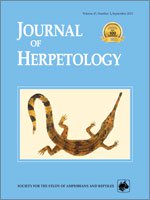Phylogeographic studies that seek to understand how a species responded to past climate change are largely lacking for the Great Basin of North America. Here we investigate the response of the Northern Desert Nightsnake (Hypsiglena chlorophaea deserticola) to the recession of the Cordilleran glacier at the end of the Pleistocene. Using mtDNA markers, we inferred the lineage age and historical demography of this widespread desert taxon. We find that H. c. deserticola maintained a stable population size throughout the late Pleistocene despite ice-sheet advance and retreat. These conclusions agree with other phylogeographic studies that show stable or growing population sizes throughout the Pleistocene as well as fossil evidence that sheds light on the historical distributions of snakes, suggesting that snakes have been adaptable to historical climatic fluctuations.
How to translate text using browser tools
1 September 2013
Population Stability of the Northern Desert Nightsnake (Hypsiglena chlorophaea deserticola) during the Pleistocene
Edward A. Myers,
Robert E. Weaver,
Hugo Alamillo
ACCESS THE FULL ARTICLE

Journal of Herpetology
Vol. 47 • No. 3
September 2013
Vol. 47 • No. 3
September 2013




